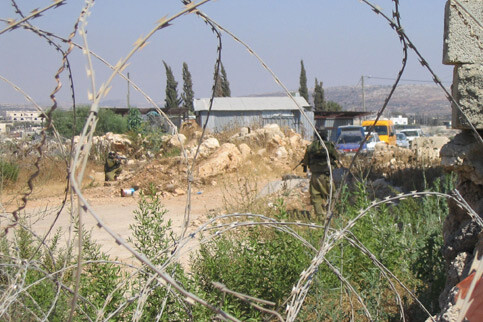
Time is so short and my experiences are so intense I fear that I cannot fully convey the gravity of daily life and what I am witnessing here. It especially worries me that the world’s eyes are myopically focused on the pullout in Ghaza, the anti-disengagement protesters, most of whom are illegal Israeli settlers from the West Bank.
Yesterday I took part in a non-violent demonstration in three villages of the Salfit area outside of Nablus. For the last few weeks, Salfit villages have been experiencing increased violence by the IDF throughout the region. Demonstrations in Marda and Immatin have been met with army incursions, tear gas, and rubber bullets. There have been daily army incursions, arrests, curfews, and closures, searches of houses, and tear gassing of homes. In Salfit, a 16-year-old boy was killed for throwing stones at a jeep.

The day began by meeting up with other two Palestinian ISMers in Ramallah. We drove to the small village of Deir Ballut. At the checkpoint just outside of the village we waited for 30 minutes while the IDF ignored us for no apparent reason. Although we were worried that no internationals would be allowed inside and that we’d have to cross into the valley surreptitiously, we managed to make it through without a problem. We drove to a partially-constructed school in Deir Ballut. The Israeli Army has halted construction on the school since June 2003 and will not allow the village to complete the school, which is funded by World Vision, a project of USAID. The non-violent demonstration consisted of around 200 school children singing songs, chanting, and giving speeches about why they want their school finished. Al Jazeera was there and interviewed many of the teachers and students who were present. Although we did not experience any clashes with the IDF there, one IDF Jeep was posted on the hill overlooking the school throughout the protest. It seems that Palestinian children wanting an education is considered a threat to the Israeli state.

The second non-violent activity took place in the village of Az Zawiya. We listened to speeches given by local residents, city council members, Women for Life, and girls from a local summer camp to discuss effects of the Israeli Occupation and construction on the Annexation Barrier in Az Zawiya and neighboring villages. Many of the speakers discussed funding for agricultural and infrastructural projects on their land, as they fear that any land not deemed as being used by the Israelis will add to the land grab already taking place by the construction of the Apartheid Wall.
The final stop, which was the most disturbing by far, took place at the home of Hani Aamer in Mas’ha. Since the erection of the Annexation Wall in Mas’ha two years ago, the Aamer house has been surrounded on all four sides. The family may only enter and leave when soldiers open the gates. On one side is the 26 foot high Apartheid Wall with a colorful mural illustrated by children. On two other sides is an electric fence, which the IDF controls; the IDF maintains a checkpoint on one side of the fence and an illegal Israeli settlement is on the other side. About twenty people, Palestinians, ISM activists, and the media visited the Aamer family. After five minutes an additional 6 army Jeeps arrived and threatened that we would have problems if we did not leave in 5 minutes. This type of demonstration is a solidarity visit; it was not a protest in the traditional sense of the word. And yet the IDF became violent, reoccupied the rest of Mas’ha outside of the Annexation Wall and began to point their M16 guns in strategic directions. While many of us wanted to stay and support the family, their isolation meant that they could likely suffer after we left. So we escorted the Palestinian visitors out and that was the end of the demonstration.

The living conditions of Hani Aamer and his family is not unique. There are other Palestinian families who are blocked in like this and who have to deal with the illegal Israeli settler children throwing stones at them. The IDF, who maintains its outpost right there, never responds when the Aamer family complains about this. However, the minute one of Aamer’s family members throws a stone in return, the IDF responds. Hani Aamer is a 1948 Palestinian who lost his home once and refuses to leave because he doesn’t want to lose his home a second time. I don’t know if anyone can imagine what this family’s life must be like living in a literal prison whose movement is entirely dependent upon the whim of the IDF soldiers.
Marcy Newman is assistant professor of English at Boise State University and Legislative Coordinator for the U.S. Campaign to End the Occupation for Idaho’s District 2.
Related Links



